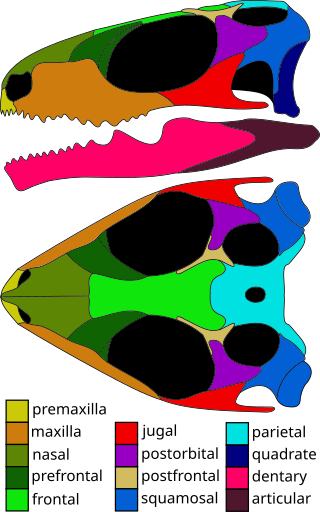
The Lepidosauria is a subclass or superorder of reptiles, containing the orders Squamata and Rhynchocephalia. Squamata also includes lizards and snakes. Squamata contains over 9,000 species, making it by far the most species-rich and diverse order of non-avian reptiles in the present day. Rhynchocephalia was a formerly widespread and diverse group of reptiles in the Mesozoic Era. However, it is represented by only one living species: the tuatara, a superficially lizard-like reptile native to New Zealand.

Rhynchocephalia is an order of lizard-like reptiles that includes only one living species, the tuatara of New Zealand. Despite its current lack of diversity, during the Mesozoic rhynchocephalians were a speciose group with high morphological and ecological diversity. The oldest record of the group is dated to the Middle Triassic around 238 to 240 million years ago, and they had achieved global distribution by the Early Jurassic. Most rhynchocephalians belong to the group Sphenodontia ('wedge-teeth'). Their closest living relatives are lizards and snakes in the order Squamata, with the two orders being grouped together in the superorder Lepidosauria.

Sphenodontidae is a family within the reptile group Rhynchocephalia, comprising taxa most closely related to the living tuatara. Historically the taxa included within Sphenodontidae have varied greatly between analyses, and the group has lacked a formal definition. Cynosphenodon from the Jurassic of Mexico has consistently been recovered as a close relative of the tuatara in most analyses, with the clade containing the two and other very close relatives of the tuatara often called Sphenodontinae. The herbivorous Eilenodontinae, otherwise considered part of Opisthodontia, is considered to be part of this family in many recent studies as the sister group to Sphenodontinae. The earliest Sphenodontines are known from the Early Jurassic of North America, with other remains known from the Late Jurassic of Europe, the Late Cretaceous and possibly Paleocene of South America and the Miocene-recent of New Zealand. Sphenodontines are characterised by a complete lower temporal bar caused by the fusion of a forward directed process (extension) of the quadrate/quadratojugal and the jugal, which was an adaptation for reducing stress in the skull during hard biting. Other synapomorphies of Sphenodontinae include the presence of nasal foramina, a posterodorsal process of the coronoid of the lower jaw, the present of caniniform successional teeth at the front of the jaws, the presence of flanges on the posterior parts of teeth at back of the lower jaw, and an expanded radial condyle on the humerus. Like modern tuatara, members of Sphenodontinae were likely generalists with a carnivorous/insectivorous diet.

Planocephalosaurus is an extinct genus of basal rhynchocephalian. Fossils of the genus are primarily known from fissure fill deposits from the Late Triassic of southwest Britain, with fragmentary remains possibly belonging to the genus also known from the Late Triassic of Texas.

Homoeosaurus is an extinct genus of rhynchocephalian reptile, known from the Late Jurassic-earliest Cretaceous of Europe, with specimens being reported from France, England and Germany. Several species have been described within the genus, based on varying proportions of the limb bones to the body length based on the presacral vertebrae. Specimen C.M.6438 of H. maximiliani from Germany has a total length of around 17 centimetres (6.7 in), with a skull length of about 1.7 centimetres (0.67 in). In comparison to other rhynchocephalians, the limbs are proportionally long. Recent studies have classified Homoeosaurus as a member of Neosphenodontia, with some studies including it as part of the clade Leptorhynchia, also including sapheosaurs, pleurosaurs, Kallimodon and Vadasaurus. Despite being found in aquatic deposits, it is suggested to have been terrestrial. It is thought to have been a carnivore/insectivore. One specimen was found as stomach contents of the fish Belonostomus.

Brachyrhinodon is an extinct genus of sphenodontian from the Late Triassic Lossiemouth Sandstone of Scotland.

Clevosaurus is an extinct genus of rhynchocephalian reptile from the Late Triassic and the Early Jurassic periods. Species of Clevosaurus were widespread across Pangaea, and have been found on all continents except Australia and Antarctica. Five species of Clevosaurus have been found in ancient fissure fill deposits in south-west England and Wales, alongside other sphenodontians, early mammals and dinosaurs. In regards to its Pangaean distribution, C. hadroprodon is the oldest record of a sphenodontian from Gondwana, though its affinity to Clevosaurus has been questioned.

Cynosphenodon is an extinct genus of rhynchocephalian in the family Sphenodontidae from the Middle Jurassic La Boca Formation of Tamaulipas, Mexico. It is known from a largely complete lower jaw and fragments of the upper jaw. It is suggested to be among the closest known relatives of the tuatara, with both being placed in the Sphenodontinae, which is supported by among other characters, the growth pattern of the teeth.
The La Boca Formation is a geological formation in Tamaulipas state, northeast Mexico. It was originally thought to date back to the Early Jurassic, concretely the Pliensbachian stage epoch of 193-184 Ma. Later studies found that while the unit itself was likely deposited during the earliest Pliensbachian, as proven by zircon dating 189.0 ± 0.2 Ma, the local vulcanism continued until the Bajocian.

Opisthias is a genus of sphenodont reptile. The type species, Opisthias rarus, is known from the Late Jurassic (Kimmeridgian-Tithonian) of western North America.

Diphydontosaurus is an extinct genus of small rhynchocephalian reptile from the Late Triassic of Europe. It is the most primitive known member of Sphenodontia.

Gephyrosaurus is an extinct genus of lepidosaurian reptile known from the Late Triassic to Early Jurassic of the United Kingdom. It is generally considered to be one of the most primitive members of the clade Rhynchocephalia.

Marmoretta is an extinct genus of small lepidosauromorph reptile known from the Middle Jurassic (Bathonian) of Britain, as well as the Late Jurassic of Portugal. It contains a single species, Marmoretta oxoniensis.
Sphenocondor is an extinct genus of sphenodontian reptile from the Early Jurassic Cañadón Asfalto Formation of Argentina. It is known from a nearly complete lower jaw.

The Erfurt Formation, also known as the Lower Keuper, is a stratigraphic formation of the Keuper group and the Germanic Trias supergroup. It was deposited during the Ladinian stage of the Triassic period. It lies above the Upper Muschelkalk and below the Middle Keuper.

Sphenovipera jimmysjoyi is an extinct species of sphenodontian dated from the Middle Jurassic. If was discovered in the lower part of the La Boca Formation located in Tamaulipas, Mexico. Only the lower jaw of this organism has been discovered and studied. It is possibly the only species of rhynchocephalian yet discovered to show evidence of venom delivery.
Rebbanasaurus is an extinct sphenodontian reptile known from remains found in the Early-Middle Jurassic Kota Formation of India. The type specimen is a partial jawbone which has acrodont teeth, with other known remains including fragments of the premaxilla, maxilla, and palatine. It was relatively small, with a skull estimated at 1.5–2.5 centimetres (0.59–0.98 in) long. It is generally considered to be a relatively basal sphenodontian that lies outside Eusphenodontia.

Opisthodontia is a proposed clade of sphenodontian reptiles, uniting Opisthias from the Late Jurassic-earliest Cretaceous of Europe and North America with the Eilenodontinae, a group of herbivorous sphenodontians known from the Late Triassic to Late Cretaceous.

Sapheosaurs are an extinct group of rhynchocephalian reptiles from the Late Jurassic period. "Sapheosaurs" is an informal name for a group of rhynchocephalians closely related to the genus Sapheosaurus. It was first recognized as a group containing multiple genera by Hoffstetter in 1955. The group has sometimes been given a formal taxonomic name as the family Sapheosauridae, although in some analyses this group belongs to the family Sphenodontidae and thus cannot be assigned its own family. They were fairly advanced rhynchocephalians which may have had semiaquatic habits.

Opisthiamimus is an extinct genus of small-bodied eusphenodontian rhynchocephalian from the Upper Jurassic Morrison Formation of Northern Wyoming, United States. The type species, O. gregori, is known from four specimens, which together preserve a nearly complete skeleton. It is amongst the smallest known rhynchocephalians, with a skull length of 2.05 centimetres (0.81 in) and a snout–vent length of around 8.5 centimetres (3.3 in). The genus was described in 2022 by David DeMar, Marc E. H. Jones, and Matthew Carrano. It was found that it was only distantly related to Eilenodon, Theretairus and Opisthias, the other known rhynchocephalians from the Morrison Formation.
















